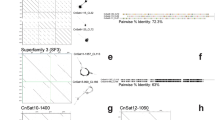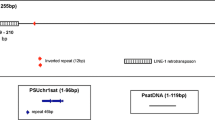Abstract
The genomes of the egg-laying platypus and echidna are of particular interest because monotremes are the most basal mammal group. The chromosomal distribution of an ancient family of short interspersed repeats (SINEs), the core-SINEs, was investigated to better understand monotreme genome organization and evolution. Previous studies have identified the core-SINE as the predominant SINE in the platypus genome, and in this study we quantified, characterized and localized subfamilies. Dot blot analysis suggested that a very large fraction (32% of the platypus and 16% of the echidna genome) is composed of Mon core-SINEs. Core-SINE-specific primers were used to amplify PCR products from platypus and echidna genomic DNA. Sequence analysis suggests a common consensus sequence Mon 1-B, shared by platypus and echidna, as well as platypus-specific Mon 1-C and echidna specific Mon 1-D consensus sequences. FISH mapping of the Mon core-SINE products to platypus metaphase spreads demonstrates that the Mon-1C subfamily is responsible for the striking Mon core-SINE accumulation in the distal regions of the six large autosomal pairs and the largest X chromosome. This unusual distribution highlights the dichotomy between the seven large chromosome pairs and the 19 smaller pairs in the monotreme karyotype, which has some similarity to the macro- and micro-chromosomes of birds and reptiles, and suggests that accumulation of repetitive sequences may have enlarged small chromosomes in an ancestral vertebrate. In the forthcoming sequence of the platypus genome there are still large gaps, and the extensive Mon core-SINE accumulation on the distal regions of the six large autosomal pairs may provide one explanation for this missing sequence.
Similar content being viewed by others
References
Bick YA, Sharman GB (1975) The chromosomes of the platypus (Ornithorynchus: Monotremata) Cytobios 14: 17–8.
Bininda-Emonds OR, Cardillo M, Jones KE et al. (2007) The delayed rise of present-day mammals. Nature 446(7135): 507–12.
Boyle AL, Ballard SG, Ward DC (1990) Differential distribution of long and short interspersed element sequences in the mouse genome: chromosome karyotyping by fluorescence in situ hybridization. Proc Natl Acad Sci USA 87(19): 7757–761.
Brosius J (1999) RNAs from all categories generate retrosequences that may be exapted as novel genes or regulatory elements. Gene 238(1): 115–34.
Burt DW (2002) Origin and evolution of avian microchromosomes. Cytogenet Genome Res 96(1–4): 97–12.
Church GM, Gilbert W (1984) Genomic sequencing. Proc Natl Acad Sci USA 81(7): 1991–995.
Dewannieux M, Esnault C, Heidmann T (2003) LINE-mediated retrotransposition of marked Alu sequences. Nat Genet 35(1): 41–8.
Gentles AJ, Wakefield MJ, Kohany O et al. (2007) Evolutionary dynamics of transposable elements in the short-tailed opossum Monodelphis domestica. Genome Res 17(7): 992–004.
Gilbert N, Labuda D (1999) CORE-SINEs: eukaryotic short interspersed retroposing elements with common sequence motifs. Proc Natl Acad Sci USA 96(6): 2869–874.
Gilbert N, Labuda D (2000) Evolutionary inventions and continuity of CORE-SINEs in mammals. J Mol Biol 298(3): 365–77.
Grützner F, Graves JAM (2004) A platypus’ eye view of the mammalian genome. Curr Opin Genet Dev 14(6): 642–49.
Gu W, Ray DA, Walker JA et al. (2007) SINEs, evolution and genome structure in the opossum. Gene 396(1): 46–8.
Janke A, Magnell O, Wieczorek G, Westerman M, Arnason U (2002) Phylogenetic analysis of 18S rRNA and the mitochondrial genomes of the wombat, Vombatus ursinus, and the spiny anteater, Tachyglossus aculeatus: increased support for the Marsupionta hypothesis. J Mol Evol 54(1): 71–0.
Jurka J, Zietkiewicz E, Labuda D (1995) Ubiquitous mammalian-wide interspersed repeats (MIRs) are molecular fossils from the mesozoic era. Nucleic Acids Res 23(1): 170–75.
Korenberg JR, Rykowski MC (1988) Human genome organization: Alu, lines, and the molecular structure of metaphase chromosome bands. Cell 53(3): 391–00.
Lander ES, Linton LM, Birren B et al. (2001) Initial sequencing and analysis of the human genome. Nature 409(6822): 860–21.
Lenoir A, Lavie L, Prieto JL et al. (2001) The evolutionary origin and genomic organization of SINEs in Arabidopsis thaliana. Mol Biol Evol 18(12): 2315–322.
Margulies EH, Maduro VV, Thomas PJ et al. (2005) Comparative sequencing provides insights about the structure and conservation of marsupial and monotreme genomes. Proc Natl Acad Sci USA 102(9): 3354–359.
Matthey R (1949) Les chromosomes des vertebrées. Lucerne: F. Rouge.
Ohshima K, Hamada M, Terai Y, Okada N (1996) The 3′ ends of tRNA-derived short interspersed repetitive elements are derived from the 3′ends of long interspersed repetitive elements. Mol Cell Biol 16(7): 3756–764.
Okada N, Hamada M (1997) The 3′ ends of tRNA-derived SINEs originated from the 3′ ends of LINEs: a new example from the bovine genome. J Mol Evol 44(Supplement 1): S52–6.
Ono T, Kondoh Y, Kagiyama N, Sonta S, Yoshida MC (2001) Genomic organization and chromosomal distribution of rat ID elements. Genes Genet Syst 76(4): 213–20.
Perani P, Caccio S, Saccone S, Andreozzi L, Bernardi G (2000) Telomeres in warm-blooded vertebrates are composed of GC-rich isochores. Biochem Genet 38(7–8): 227–39.
Perez J, Garcia-Vazquez E, Moran P (1999) Physical distribution of SINE elements in the chromosomes of Atlantic salmon and rainbow trout. Heredity 83 (Pt 5): 575–79.
Rajcan-Separovic E, Sabour MP (1993) Fluorescence in situ hybridization of bovine Alu-like sequences to bovine and ovine chromosomes. Genome 36(5): 984–86.
Rens W, Grutzner F, O’Brien PC et al. (2004) Resolution and evolution of the duck-billed platypus karyotype with an X1Y1X2Y2X3Y3X4Y4X5Y5 male sex chromosome constitution. Proc Natl Acad Sci USA 101(46): 16257–6261.
Saccone S, De Sario A, Della Valle G, Bernardi G (1992) The highest gene concentrations in the human genome are in telomeric bands of metaphase chromosomes. Proc Natl Acad Sci USA 89(11): 4913–917.
Schmid CW, Jelinek WR (1982) The Alu family of dispersed repetitive sequences. Science 216(4550): 1065–070.
Smit AF, Riggs AD (1995) MIRs are classic, tRNA-derived SINEs that amplified before the mammalian radiation. Nucleic Acids Res 23(1): 98–02.
Surzycki SA, Belknap WR (2000) Repetitive-DNA elements are similarly distributed on Caenorhabditis elegans autosomes. Proc Natl Acad Sci USA 97(1): 245–49.
Tachida H (1996) A population genetic study of the evolution of SINEs. II. Sequence evolution under the master copy model. Genetics 143(2): 1033–042.
VanBrink J (1959) L’expression morphologique de la diagametie chez les sauropsids et les monotremes [Morphological form of digametism in the Sauropsida and the Monotremata.]. Chromosoma 10(1): 1–2.
Warren WC, Hillier LW, Graves JAM et al. (2007) Genome analysis of the platypus distinguishes derived mammalian from ancestral reptilian features. Nature (in press).
Wrigley JM, Graves JAM (1988) Karyotypic conservation in the mammalian order monotremata (subclass Prototheria). Chromosoma 96(3): 231–47.
Author information
Authors and Affiliations
Corresponding author
Rights and permissions
About this article
Cite this article
Kirby, P.J., Greaves, I.K., Koina, E. et al. Core-SINE blocks comprise a large fraction of monotreme genomes; implications for vertebrate chromosome evolution. Chromosome Res 15, 975–984 (2007). https://doi.org/10.1007/s10577-007-1187-1
Received:
Revised:
Accepted:
Published:
Issue Date:
DOI: https://doi.org/10.1007/s10577-007-1187-1




